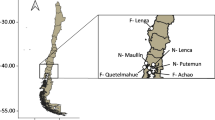Summary
Germanium acid, a specific inhibitor of the silicic acid metabolism in diatoms, inhibits the growth of Sinapis alba, Lemna minor, Wolffia arrhiza, Nicotiana tabacum, Tradescantia spec, Zinnia elegans, and Secale cereale when applied in the same concentrations as those used in the case of diatoms (15–75 μg GeO2/ml medium). The growth of Aspergillus niger, Phycomyces blakesleanus, Escherichia coli K 12, Euglena gracilis and Pandorina morum is not influenced by these and higher concentrations of Germanium acid. By application of high concentrations of silicic acid, the growth inhibition produced by germanium acid in Lemna minor is partially reduced. Plants of Lemna minor which have been inhibited by germanium acid are essentially smaller than plants grown in a normal medium; their chlorophyll content is significantly decreased. The growth of the roots in Lemna is particularly inhibited. Isolated growing roots of Lycopersicon pimpinellifolium Mill. are inhibited by small concentrations of Ge(OH)4 (ca. 1,5×10-4 M/l). In contrast to the growth of older plants, the germination of Secale cereale and Sinapis alba is not influenced by Ge(OH)4. The effects of germanium acid are discussed in relation to the physiological role of silicic acid. The results suggest that the element silicon, in the form of silicic acid, is generally essential for the normal development of higher plants.
Similar content being viewed by others
Literature
Bollard, E. G., and G. W. Butler: Mineral nutrition of plants. Ann. Rev. Plant Physiol. 17, 77–112 (1966).
Bornkamm, R.: Die Rolle des Oxalats im Stoffwechsel höherer grüner Pflanzen. Untersuchungen an Lemna minor L. Flora (Jena) 156, 139–171 (1965).
Cathey, H. M.: Physiology of growth retarding chemicals. Ann. Rev. Plant Physiol. 15, 271–302 (1964).
Fritz, G. J.: Assimilation of minerals by higher plants. Nature (Lond.) 197, 843–846 (1963).
Grosse-Braukmann, E.: Maßnahmen zur Mehltaubekämpfung bei verschiedenen Gerstensorten, ihre Erfolgsaussichten und ihr Einfluß auf den Mineralstoffgehalt. Z. Pflanzenernährg 65, 689 (1958).
Heller, R.: Réchèrches sur la nutrition minerale des tissus végétaux cultives in vitro. Thèse Paris 1953.
Hewitt, E. J.: The essential nutrient elements: requirements and interactions in plants. In: Plant physiology, vol 3, p. 137–360. New York: Academic Press 1963.
James, W. O.: Pflanzenphysiologie. Berlin: Paul Parey 1965.
Jones, L. H. P., A. A. Milne, and S. M. Wadham: Studies of silica in the oat plant II. Distribution of the silica in the plant. Plant and Soil 18, 358–371 (1963).
Knickmann, E.: Silizium und Pflanze. Landwirtsch. Forsch. 15, 130–134 (1962).
Knop, W.: Quantitativ analytische Arbeiten über den Ernährungsprozeß der Pflanzen. Landwirtsch. Vers.-Stat. 3, 295–324 (1861).
Kuhl, A., and H. Lorenzen: Handling and culturing of Chlorella. In: D. M. Prescott, Methods in cell physiology, vol. I p. 159–187. New York and London: Academic Press 1964.
Lanning, F. C., B. W. X. Ponnaiya, and C. F. Crumpton: The chemical nature of silica in plants. Plant Physiol. 33, 339–343 (1958).
Lewin, J. C.: Silicon metabolism in diatoms I. Evidence for the role of reduced sulfur compounds in Si-utilization. J. gen. Physiol. 37, 589–599 (1954).
—: Silicon metabolism in diatoms V. Germanium Dioxide, a specific inhibitor of diatom growth. Phycologia 6, 1–12 (1966).
Lockhart, J. A.: Kinetic studies of certain anti-gibberellins. Plant Physiol. 37, 759–764 (1962).
Müller, H. M.: Untersuchungen zum Säurestoffwechsel von Aspergillus niger. Arch. Mikrobiol. 52, 251–265 (1965).
Okuda, A., and E. Takahashi: The role of silicon. In: Mineral nutrition of the rice plant, chap. 10, p. 123–146. Proc. Internat. Conf. Rice Res. Inst., Los Banos, Philipines, Februar 1964. Baltimore: John Hopkins Press 1965.
Parry, D. W., and F. Smithson: Types of opaline silica depositions in the leaves of british grasses. Ann. Bot. 28, 169–185 (1964).
Sachs, J. v.: Lectures on the physiology of plants. English ed. oxford: Clarendon Press 1887.
Scheefer, F. u. R. Henze: Die Bedeutung des Siliziums in Thomasschlacken für die Ernährung von Pflanzen. Phosphorsäure 22, 242–248 (1962).
Schopfer, W. H.: Vitamine und Wachstumsfaktoren bei den Mikroorganismen, mit besonderer Berücksichtigung des Vitamins B1. Ergebn. Biol. 16, 1–172 (1939).
Stiles, W.: Essential micro-(trace) elements In: Handbuch der Pflanzenphysiologie, (Herausg. G. Michael), Bd. IV, S. 558–614. Berlin-Göttingen-Heidelberg: Springer 1958.
Tolbert, N. E.: Gibberellins. Advances in chemistry. Ser. Amer. Chem. Soc. 28, 145–151 (1961).
Ulrich, W.: Vergleichende Untersuchungen an Euglena und Chlorella bei autotropher, mixotropher und heterotropher Ernährung. Diss. Göttingen 1964.
Umemura, Y., I. Nishida, T. Akazawa, and I. Uritani: Effects of silicon compounds on plant enzymes, involved in phosphorus metabolism. Arch. Biochem. 92, 392–398 (1961).
Volk, R. J., R. P. Kahn, and R. L. Weintraub: Silicon content of the rice plant as a factor influencing its resistance to infection by the blastfungus Pirizularia oryzae. Phytopathology 48, 179–184 (1958).
Wagner, F.: Die Bedeutung der Kieselsäure für das Wachstum einiger Kulturpflanzen, ihren Nährstoffhaushalt und ihre Anfälligkeit gegen echte Mehltaupilze. Phytopath. Z. 12, 427–479 (1940).
Werner, D.: Die Kieselsäure im Stoffwechsel von Thalassiosira fluviatilis Hust. Diss. Göttingen 1965.
—: Die Kieselsäure im Stoffwechsel von Cyclotella cryptica Reimann, Lewin und Guillard. Arch. Mikrobiol. 55, 278–308 (1966).
Werner, D.: Hemmung der Chlorophyllsynthese und der NADP+-abhängigen Glycerinaldehyd-3-Phosphat-Dehydrogenase durch Germaniumsäure bei Cyclotella cryptica. Arch. Mikrobiol. (im Druck) (1967).
White, P. R.: The cultivation of animal and plant cells. New York: Ronald Press Co. 1954.
Wittwer, S. H., and N. E. Tolbert: 2-Chloroethyl-trimethylammoniumchlorid and related compounds as plant growth substances V. Growth, flowering and fruiting responses as related to those, induced by auxin and gibberellin. Plant Physiol. 35, 871–877 (1960).
Author information
Authors and Affiliations
Rights and permissions
About this article
Cite this article
Werner, D. Untersuchungen über die Rolle der Kieselsäure in der Entwicklung höherer Pflanzen. Planta 76, 25–36 (1967). https://doi.org/10.1007/BF00387419
Received:
Issue Date:
DOI: https://doi.org/10.1007/BF00387419




